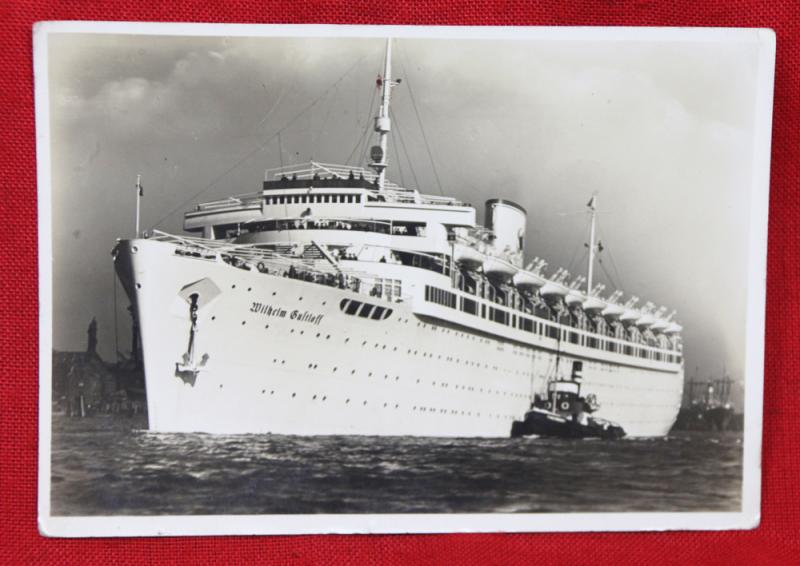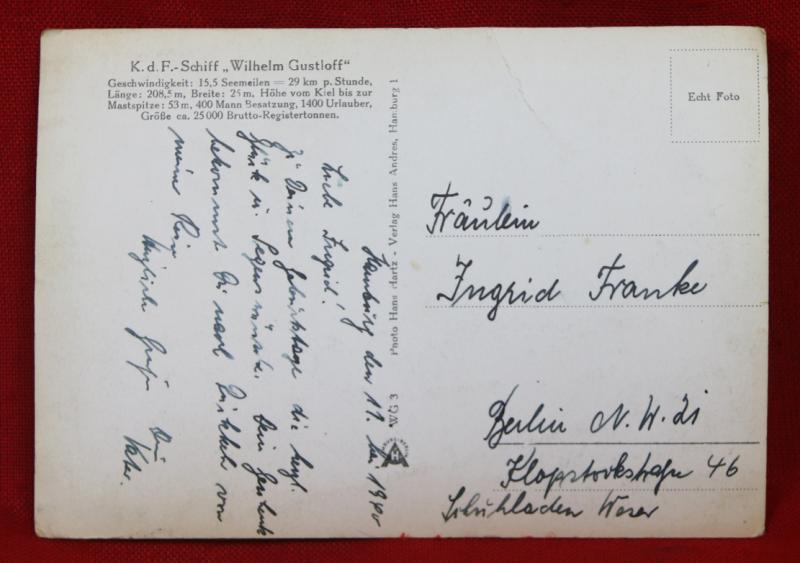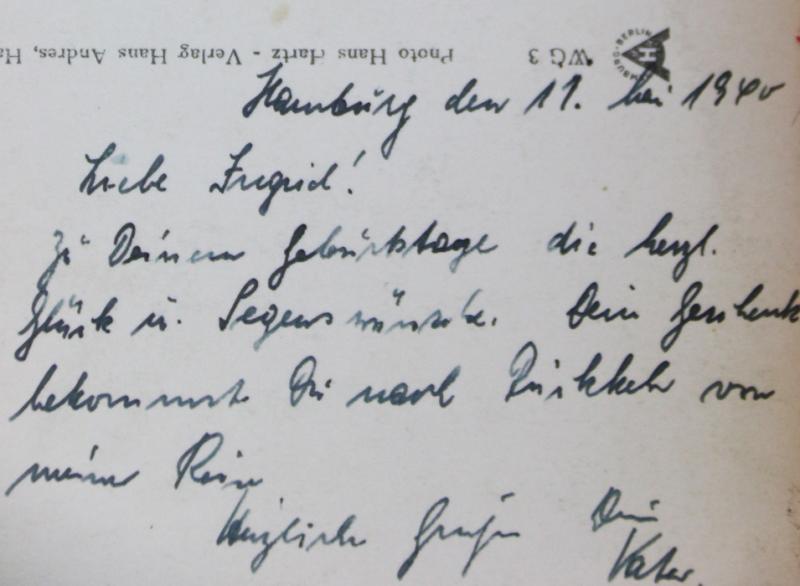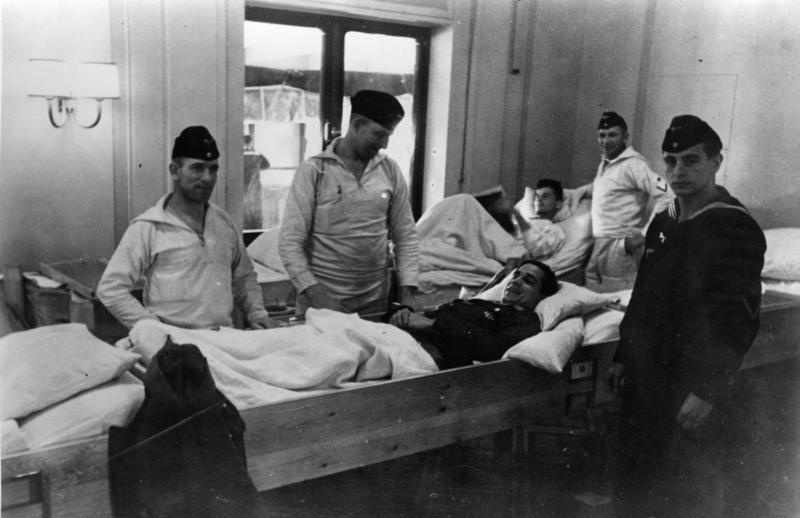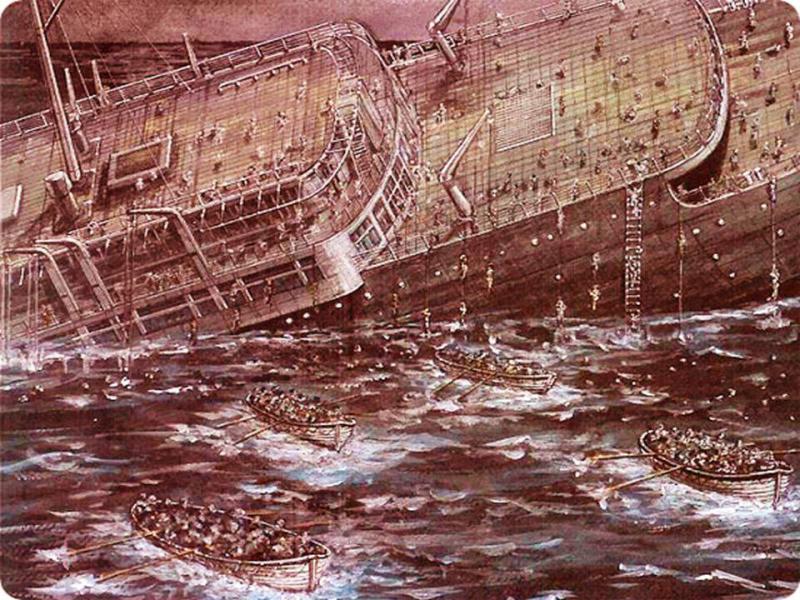A Rare Original Handwritten German Picture Postcard From Hitler's Titanic, One of The Most Famous Ships of WW2. German Ship Sunk By Soviet Submarine with the Loss of up to 11,000 Lives Making It The Greatest Loss in Worldwide Maritime History
It is most rare to find an original, dated, addressed and handwritten postcard from the Willhelm Gustloff.
MV Wilhelm Gustloff was a German military transport ship which was sunk on 30 January 1945 by Soviet submarine S-13 in the Baltic Sea while evacuating civilian evacuees from East Prussia, Lithuania, Latvia, Poland and Estonia and German military personnel from Gotenhafen (Gdynia) as the Red Army advanced. By one estimate, 9,400 people died, making it the largest loss of life in a single ship sinking in history.
Originally constructed as a cruise ship for the Nazi Strength Through Joy (Kraft durch Freude) organization in 1937, Wilhelm Gustloff had been requisitioned by the Kriegsmarine (German navy) in 1939. She served as a hospital ship in 1939 and 1940. She was then assigned as a floating barracks for naval personnel in Gotenhafen before being fitted with anti-aircraft guns and put into service to transport evacuees in 1945.
Headline from a German newspaper recording the disaster, translation;
"Wilhelm Gustloff" - Disaster
Party stormed with inquiries
The offices of the Party and the Navy in all parts of the Reich were yesterday stormed by anxious persons, who suspect that their relatives were perhaps onboard the "Wilhelm Gustloff", which was torpedoed by a Russian submarine on January 30th at 9:00 pm in the Danzig Bay and sunk within 15 minutes. The number of victims of the "Wilhelm Gustloff" disaster is still not certain, since no office of the Party or of the Kriegsmarine can accurately say, how many Eastern refugees and members of the Wehrmacht were on board, when the ship left Gotenhafen.
932 saved
On the basis of the latest research, it must be assumed that not 8,000, as we reported yesterday, but 10 to 11,000 passengers were on board. Only 932 were saved. Of which 658 were members of the Kriegsmarine. Serious accusations are now being raised against the Danzig Party offices, who insisted that the "Wilhelm Gustloff" should depart on January 30th, even though the head of the Security Baltic Sea had pointed out that the necessary number of security units could not be placed before February 4.
The "Wilhelm Gustloff" departed nevertheless on the 30th of January in the evening with the completely inadequate securing from an outpost boat and two R-boats. All the decks of the "Wilhelm Gustloff" were so crowded that no one could move. At the embarkation it was said, the journey takes however only a few hours.When the ship was hit by the Russian torpedo at exactly 9 o'clock pm, just an hour after the departure, hardly anybody could escape from the lower decks. Many passengers were thrown into the sea at the time the ship capsized, frozen in the icy water before they could be helped.
Survivors report the horror scene, which took place after the explosion onboard the ship. All lights on board are extinguished at a stroke. In wild panic, the passengers tried to find a way to the deck despite the darkness. Hundreds of women and children were trampled to death on the stairs and corridors.
Women and children
In the fierce battle that took place around the few rescue boats, women and children were ruthlessly pushed overboard. After just ten minutes, the 25,000 - ton ship listed hard. Five minutes later, the "Wilhelm Gustloff" capsized and took many thousands with her into the depth. Others, who had fallen from the deck or hurled into the sea, fell into the wake of the sinking ship and disappeared into the flood. The "Wilhelm Gustloff" was finished in 1937 as a KdF ship and was taken over by the Kriegsmarine in 1940 first as a hospital ship. Since March 1941 she was the home of the submarine teaching division in Gotenhafen.
The newspaper is shown for education purposes only
Code: 24443

